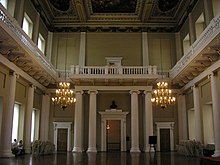Banqueting House

The Banqueting House in Whitehall , Westminster , London ( UK ) is the only building in Whitehall Palace that still exists today , which burned down in 1698.
architecture
The Banqueting House was designed by Inigo Jones , who was inspired by the buildings of the Italian architect Andrea Palladio , for the Stuart King James I and built under his direction from 1619 to 1622. Isaac de Caus installed a grotto in the basement . It is the third banquet hall at this point. The first hall was demolished under James I, the second destroyed by fire. With the third building, London received its first classical building. The Banqueting House was a milestone in the history of English architecture and founded the so-called Palladian Style ( Palladianism ). Mainly Portland stone , from which today's facade is made , was used for the construction .
Today the building is open to tourists as a sight.
Banquet hall
While the barely exposed three-aisled base storey is only used for commercial purposes, the double-cubic banquet hall is the showpiece of the building. At 17 × 34 × 17 meters, it takes up the entire floor space of the house and extends over two floors. This subdivision, which can be read on the outside of the window zone, is marked in the hall by a surrounding gallery. Ionic columns support the gallery, from which Corinthian columns rise up to the ceiling, the most magnificent and valuable part of the banquet hall.
Ceiling painting
The ceiling paintings of the banquet hall were created between 1630 and 1634, ie already during the reign of Charles I. They come from Peter Paul Rubens and his workshop, for which the painter received the enormous sum of 3,000 pounds at the time and was knighted. The paintings show homage to the rulers of the Stuart dynasty , especially Jacob I. The oval central field depicts the apotheosis of Jacob I, accompanied by the personifications of justice , religion, honor and victory . On the neighboring field on the entrance side, Minerva crowns the Infante Karl, the son and successor of Jacob as King of England and Scotland. The image field opposite to the south is dedicated to the father, he points to the allegorical figures of peace and prosperity, while Minerva drives away the turmoil, a figuratively expressed hope that was not to come true: A bust above the entrance still reminds us today that Charles I. was executed in front of the building on January 30, 1649.
literature
- Heinfried Wischermann: London , Stuttgart: Kohlhammer, 1985, pp. 73-74 (with floor plans, ground floor and upper floor swapped).
- John Summerson: Architecture in Britain 1530 to 1830 , (Pelican History of Art) London 1953, pp. 76-78.
Web links
Coordinates: 51 ° 30 ′ 16 ″ N , 0 ° 7 ′ 32 ″ W.

